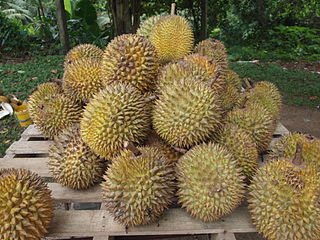
Phaseolus acutifolius, also known as the tepary bean, is a legume native to the southwestern United States and Mexico and has been grown there by the native peoples since pre-Columbian times. It is more drought-resistant than the common bean and is grown in desert and semi-desert conditions from Arizona through Mexico to Costa Rica. The water requirements are low. The crop will grow in areas where annual rainfall is less than 400 mm (16 in).

Chaetocarpus is a plant genus of the family Peraceae, formerly Euphorbiaceae, first described as a genus in 1854. Chaetocarpus species are trees or shrubs. They are native to the Americas, Africa, and Asia. Some species are endangered.
- Chaetocarpus acutifolius(Britton & P.Wilson) Borhidi – Sierra de Moa in Cuba
- Chaetocarpus africanusPax – C Africa
- Chaetocarpus castanocarpus(Roxb.) Thwaites – SE Asia, Yunnan, Assam, Bangladesh, Sri Lanka
- Chaetocarpus cordifolius(Urb.) Borhidi – Cuba, Hispaniola, Jamaica
- Chaetocarpus coriaceusThwaites – Sri Lanka
- Chaetocarpus cubensisFawc. & Rendle – Cuba
- Chaetocarpus echinocarpus (Baill.) Ducke – Bolivia, Brazil
- Chaetocarpus ferrugineusPhilcox – Sri Lanka
- Chaetocarpus gabonensisBreteler – Gabon
- Chaetocarpus globosus(Sw.) Fawc. & Rendle – Jamaica, Cuba, Dominican Rep.
- Chaetocarpus myrsinitesBaill. – Bolivia, Brazil
- Chaetocarpus parvifoliusBorhidi – Cuba
- Chaetocarpus pearceiRusby – Bolivia
- Chaetocarpus pubescens(Thwaites) Hook.f. – Sri Lanka
- Chaetocarpus rabarabaCapuron – Madagascar
- Chaetocarpus schomburgkianus(Kuntze) Pax & K.Hoffm. – Colombia, Venezuela, 3 Guianas, NW Brazil

Durio kutejensis, commonly known as durian pulu, durian merah, nyekak, Pakan, Kuluk, or lai, is a primary rainforest substorey fruit tree from Borneo.

Durio dulcis, known as durian marangang, red durian, tutong, or lahung, is a fairly large tree in the genus Durio. It can grow up to 40 m tall. The husk of its fruit is dark red to brown-red, and covered with slender 15–20 mm long spines. The fruit flesh is dark yellow, thin, and deep caramel-flavored, with a turpentine odor. The fruit of this species is considered by many to be the sweetest of all durians.

Durio grandiflorus, commonly known as durian munjit, is endemic to the island of Borneo.

The black hornbill is a species of bird of the hornbill family Bucerotidae. It lives in Asia in Brunei Darussalam, Indonesia, Malaysia, Singapore, Thailand.

Podocarpus acutifolius, commonly called needle-leaved tōtara, is a species of conifer in the family Podocarpaceae. It is found only in New Zealand.
Durio ceylanicus, the Ceylon durian, is a species of flowering plant in the family Malvaceae. It is found only in Sri Lanka. The Ceylon durian, a large prickly fruit, is inedible and does not stink.
Cullenia rosayroana is a species of flowering plant in the family Malvaceae. It is endemic to Sri Lanka.
Durio pinangianus is a species of tree in the family Malvaceae. It is endemic to Peninsular Malaysia.
Durio testudinarius, commonly known as durian kura kura is a species of durian tree in the family Malvaceae. It is endemic to Borneo.
Durio wyatt-smithii is a species of flowering plant in the family Malvaceae. It is a tree endemic to Peninsular Malaysia.

Prevost's squirrel or Asian tri-colored squirrel is a colourful species of rodent in the family Sciuridae. It is found in forests in the Thai-Malay Peninsula, Sumatra, Borneo and nearby smaller islands, with an introduced population in northern Sulawesi. Although the Prevost's squirrel is declining in some regions because of habitat loss and hunting, the species is not considered threatened since it generally remains common and widespread. It can live in somewhat disturbed habitats and often visits plantations or gardens. It mostly feeds on plant material, especially fruits, but also takes insects.

The durian is the edible fruit of several tree species belonging to the genus Durio. There are 30 recognised Durio species, at least nine of which produce edible fruit. Durio zibethinus, native to Borneo and Sumatra, is the only species available on the international market. It has over 300 named varieties in Thailand and 100 in Malaysia as of 1987. Other species are sold in their local regions.

The cave nectar bat, dawn bat, common dawn bat, common nectar bat or lesser dawn bat is a species of megabat within the genus Eonycteris. The scientific name of the species was first published by Dobson in 1871.

Gastrochilus acutifolius is a species of orchid found in Assam (India), eastern Himalayas, Nepal, Myanmar and Vietnam. The specific epithet, acutifolius, meaning "thorny leaves", is derived from Latin acutus, and -folius (-leaved), and refers to the characteristic shape of the leaves.

Potamogeton acutifolius is a European species of aquatic plant in the family Potamogetonaceae, known by the common name sharp-leaved pondweed. It is threatened and declining in at least part of its range.

Durio graveolens, sometimes called the red-fleshed durian, orange-fleshed durian, or yellow durian, is a species of tree in the family Malvaceae. It is one of six species of durian named by Italian naturalist Odoardo Beccari. The specific epithet graveolens is due to the odor. Although most species of Durio have a strong scent, the red-fleshed type of D. graveolens has a mild scent. It is native to Southeast Asia.

Durio lanceolatus is a tree in the family Malvaceae. It grows up to 55 metres (180 ft) tall.
Mount Pock Forest Reserve is a protected forest reserve in Semporna District of Tawau Division, Sabah, Malaysia. It was designated as a Class 1 Protection Forest by the Sabah Forestry Department in 1984. Its area is 7,804.8 hectares (78.048 km2). The reserve consists of steeply sloping terrain. The forest on lower slopes has been impacted by logging and conversion of land for agriculture. Oil palm plantations surround the reserve. The size of the reserve has decreased since its initial gazetting. In 2012, 1,388 ha (13.88 km2) of the Mount Pock Reserve was reclassified as state land as this area, along with parts of other reserves, have been home to indigenous communities.















